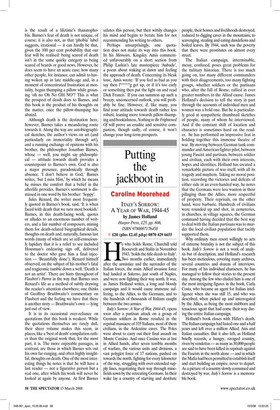Putting the jackboot in
Caroline Moorehead
ITALY’S SORROW: A YEAR OF WAR, 1944-45 by James Holland Harper Press, £25, pp. 606, ISBN 9780007176458 ✆ £20 (plus £2.45 p&p) 0870 429 6655 He who holds Rome, Churchill told Roosevelt and Stalin in November 1943, ‘holds the title deeds to Italy’. Two months earlier, immediately after the armistice and the surrender of the Italian forces, the main Allied invasion force had landed at Salerno, just south of Naples, and were now fighting their way north. It was, as James Holland writes, a long and bloody campaign and it would cause immense suffering, to the Allies, to the Germans, and to the hundreds of thousands of Italians caught between the two armies.
Italy’s Sorrow: A Year of War, 1944-45, opens soon after a partisan attack on a group of German soldiers in Rome resulted in the reprisal massacre of 335 Italians, most of them civilians, in the Ardeatine caves. The Poles were about to carry out their final assault on Monte Cassino. And once Cassino was at last in Allied hands, after seven terrible months of warfare, the various units and divisions, a vast polyglot force of 17 nations, pushed on towards the north, fighting for every kilometer of the way, struggling with over-extended supply lines, negotiating their way through minefields sown by the retreating Germans. In their wake lay a country of starving and destitute people, their homes and livelihoods destroyed, reduced to digging caves in the mountains, to scavenging, stealing and eating dandelions and boiled leaves. By 1944, such was the poverty that there were prostitutes on almost every street.
The Italian campaign, interminable, messy, confused, poses great problems for the military historian. There is too much going on, too many different commanders with their disagreements, too many fighting groups, whether soldiers or the partisans who, after the fall of Rome, rallied in ever greater numbers to the Allied cause. James Holland’s decision to tell the story in part through the accounts of individual men and women was a bold one. But he is particularly good at sympathetic thumbnail sketches of people, many of whom he interviewed. And if the constant shift of location and character is sometimes hard on the reader, he has performed an impressive feat in holding together this immense theatre of war. By moving between German tank commander and American fighter pilot, between young Fascist and partisan, between soldier and civilian, each with their own interests, hopes and identities, Holland has created a remarkable picture of war itself, with all its tragedy and mayhem. Taking no moral position, recording the victories and defeats of either side in an even-handed way, he notes that the Germans were less wanton in their pillaging than the Allies, more respectful of property. Their reprisals, on the other hand, were barbaric. Hundreds of civilians were rounded up and shot, in cemeteries, in churches, in village squares, the German command having decided that the best way to deal with the Italian partisans was to murder the local civilian population that tacitly supported them.
Why ordinary men resort willingly to acts of extreme brutality is not the subject of this book. Italy’s Sorrow is not a work of analysis but of description, and Holland’s research has been meticulous, covering many archives, several countries and dozens of interviews. For many of his individual characters, he has managed to follow their stories to the present day. Among the few who eluded him is one of the most intriguing figures in the book, Carla Costa, who became an agent for Italian intelligence when she was still 15, and who was described, when picked up and interrogated by the Allies, as being the most stubborn and tenacious agent that had come their way during the entire Italian campaign.
Holland’s book closes with Hitler’s death. The Italian campaign had lasted one and a half years and left over a million Allied, Axis and Italian casualties. But it also left, as Holland briefly records, a hungry, ravaged country, riven by vendettas — as many as 30,000 people are said to have been killed in reprisals against the Fascists in the north alone — and in which the Mafia had been permitted to establish itself and start building an empire, never to depart. As a picture of a country slowly consumed and destroyed by war, Italy’s Sorrow is a memorable book.


























































































 Previous page
Previous page